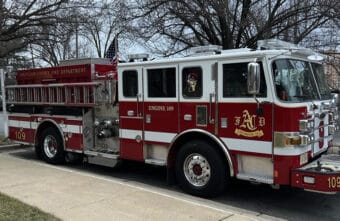Improving Law Enforcement ICS
by Roger Mason PhD
 Introduction
Introduction
Since the 1980s the United States has employed the Incident Command System (ICS) to manage disasters, emergencies, and public safety incidents. While law enforcement and the fire service share this system their application of ICS is quite different. People have complained that police organizations have lagged behind fire departments in the efficient use of ICS.
To evaluate this question, it is important to understand the differences between the two disciplines. Fire departments and police organizations have different missions and are organized differently. They have unique approaches to incident response, problem solving and operational management. Once the differences are clear it is possible to examine law enforcement procedures and offer some suggestions for improving the use of ICS.
What is ICS?
ICS is part of the National Incident Management System (NIMS). NIMS provides local, state, and federal agencies with a common system for managing disasters and emergencies.
History of ICS
In the 1970s the Incident Command System was developed in California to standardize fire fighting management practices. The original program established standard management principles for firefighting operations. The system was based on four basic elements of operations, planning, logistics, finance/administration. One of the biggest advantages of ICS was system were the common tactics, procedures, and language. These elements allowed for the seamless integration of agencies and departments during a disaster.
Gradually the principles were adopted by the federal government which developed the national Incident Management System. During this period ICS was gradually adopted for use by law enforcement agencies. ICS is now the common management operating system for public safety throughout the United States.
Public Safety Systems
Police and fire departments both operate as systems. The difference is how the members of the system interact and how they respond to their environments.
 Fire Departments as a Multi-agent System
Fire Departments as a Multi-agent System
Fire departments are organized as multi-agent systems. Multi- agent systems are composed of identical elements designed to work cooperatively to achieve a common goal. Because of their built-in organization the multi-agent system is not as sensitive to environmental change. Fire departments respond with engine companies and task forces, led by battalion chiefs. These forces arrive pre-organized and led by a built-in command staff. This is possible because US fire departments only respond in teams built around a capability based on their equipment.
Police as a Complex Adaptive System

As the system responds to environmental stimulus it adapts its organization to respond to the surrounding environment. Law enforcement organizations routinely dispatch one officer to even the most critical of incidents until additional personnel become available. During an emergency police dispatch the nearest officer(s) and they are expected to self-organize as additional officers arrive. Fire departments would never consider sending a single fire fighter until others become available.
Fire vs Law Enforcement ICS
There are unique differences in how the fire service and law enforcement employ ICS. These differences can be divided into response methodology, threat modeling and threat resolutions tactics.
Response Methodology

When the first fire units arrive at an incident, they immediately begin a process of assessment and organization. The company officer (ranking fire department member) provides the initial plan that will be employed by the responding units. These units usually include a command function designed to manage the additional resources.

A good example is an active shooter incident. The first officer on the scene is expected to seek out the suspect and either terminate the threat or prevent the shooter from becoming mobile. The backup units are expected to self-organize and assist the search for the shooter.
Threat Modeling
Police and fire have very different threat models. Fire threat as inanimate. They are based on the laws of physics, chemistry, and weather. Anthropomorphisms (attributing human qualities to non-human objects or phenomenon) are common in descriptions of fire activity. “The fire went to sleep over night but it surprised us by doubling back at first light.” This is done to personalize and simplify understanding the fire’s behavior. The problem is fire behavior is inanimate. Fires do not go to sleep or intentionally surprise firefighters by direction changes.
Police threats are primarily based on the cognitively related decisions and actions of human beings. People ambush the police and hide to avoid being arrested. Humans learn from interactions and this capacity to learn sometimes manifests itself in unique outcomes. A multiplicity of factors can make firefighting extremely complicated and dangerous. The introduction of a cognitive decision maker as the threat source takes the danger and complexity to another level.
Threat Resolution Tactics
Fire and police employ different tactics to resolve hazardous incidents. Police employ an incident response model where they will respond to the scene and continue to introduce additional officers until the incident is resolved. Fire departments employ an incident management model where they manage incidents employing preorganized teams with built in capabilities and leadership.
Understanding Law Enforcement Incidents

Unplanned Dynamic Incident: This is an incident with no prior notice. The factors involved in the incident are unpredictable and may involve sudden changes of action, a change of location, or a sudden increase or decrease of activity. (Ex: a major crime in progress)
Planned Static or Dynamic Incident: This incident may involve prior notice and presents the opportunity for event planning. It can remain static as planned or become dynamic during the event. (Ex: A peaceful demonstration that becomes violent.)
Investigative Incident: This involves an incident where the purpose of is to conduct an investigation, but the size and complexity of the investigation requires large numbers of personnel. (Ex:: searching for a missing child.)
Combined Operation/Unified Command Incident: This is an incident that involves police and fire operations. (Ex: Urban wildfire).
Law Enforcement ICS: Problems of Presumption
One of the biggest problems with law enforcement ICS are operational presumptions that Influence decisions and actions. These presumptions often affect the effectiveness of incident ICS and the resulting outcomes.
Presumption of Self-Organization
The first presumption involves the reliance on self- organization. This presumption assumes during a chaotic incident responders will naturally self- organize into a functional team.
Presumption of Time Compression/Criticality
The second presumption makes an assumption based on a faulty premise. It states the situation is so critical there is not time to organize and employ ICS. The truth is actually the opposite. The greater the criticality the more you need ICS to organize and manage operations.
Presumption of Closure

Presumption of Follow-Through
The presumption of follow-through is based on the incorrect assumption that resolving one point of criticality will lead to a successful resolution at all points. This is rarely the case. You may have neutralized the active shooter, but many problems remain. There are victims to be rescued, and there are traffic management problems at the casualty collection center. Evidence must be preserved, and witnesses interviewed. Assuming this will be managed by self-organization is more of a hope than a strategy.
When it All Comes Together (Or Falls Apart)
A good example of these presumptions is the 2022 Robb Elementary School shooting in Uvalde, Texas. Nineteen students and two teachers were killed. There have been three after-action reports which provide specific details about the incident and the response.
The initial responders included the chief of the Uvalde School Police. He made numerous requests for assistance but did not attempt to organize the response. Several police agencies responded but there was no discernable self-organization. Some officers organized their own response which resulted in the breakdown of tactical coordination.
There was a strong presumption of time compression and criticality. Instead of organizing the response groups of random police officers, disorganized attempts were made to contact the suspect. The result was a breakdown in tactical effectiveness where officers were either awaiting orders or uncertain of what action should be taken.
The final issue was a presumption of closure. The school was surrounded by dozens of officers. There were officers throughout the interior of the school. The tipping point was when members of a US Border Patrol tactical team self-deployed, without orders moved through the confusion, contacted the suspect, and neutralized him.
.
Reversing the Presumptions
In the past decade law enforcement tactics have evolved from a reactive “wait and see” approach to a combination of reaction and immediate response. The question is how police departments can optimize the use of ICS and gain the initiative during critical incidents.
Managing Instead of Self-Organization
Local police departments and their surrounding jurisdictions need standardized tactics for critical incident response. This standardization should follow the example of the fire department which has operational organization in mind from the minute the first units arrive. This will allow departments to mobilize available officers into tactical capabilities depending on the contingencies of the event. This effort at organization should occur as soon as possible.
Reversing the Effects of Time Compression

Trading Effective Action Over Disorganized Forces
It is better to effectively manage a smaller number of officers than flood a location with officers. Pictures of the Uvalde, Texas school shooting shows hallways full of officers. Several tactical officers who self-deployed, pushed their way past the crowded hallways and engaged the suspect. ICS is designed to manage an incident. The effort to establish ICS during an incident is not wasted.
Transitioning For Dynamic Events
ICS is essential for major incidents. A single incident can suddenly expand to multiple locations. A good example is the 2015 terrorist attack in San Bernadino. The suspects killed and wounded 36 victims. The initial scene rapidly expanded to three locations including a victim relocation and interview center and the location of the final armed confrontation.
The incident was complicated when it was discovered the suspects had improvised exploding devices. After an active shooter is neutralized the efforts to rescue victims, transport the injured, preserve evidence and manage traffic continues. One of the advantages of ICS is its ability to expand to meet the size of the incident. The complexity level of a multi scene incident requires the oversight and resource management that ICS can offer.
Moving Forward

- There needs to be standardized protocols for critical incident response. If you evaluate fire service or emergency room procedures across the US you would find a great deal of standardization. This is not always the case with law enforcement. There are continual efforts to develop new protocols that eliminate the mistakes from the last critical incident. Learning from mistakes is essential but at some point, it becomes more valuable to employ a standard procedure rather than constantly seeking new solutions.
- Law enforcement needs to move to a combined response/management model. There are limits to self-organization. During a critical incident the early introduction of ICS improves resource management optimization.
- Police officers often see an incident through a single responder lens,preventing the efficient transition to ICS. ICS needs to be built into law enforcement incident management protocols. Too often it is an afterthought that is disconnected from operational efforts. Fire departments have developed prepackaged incident management teams and resources allowing them to rapidly take control large incidents.
- Law enforcement should develop response protocols that include ICS. Police respond and if necessary, establish ICS. This is a problem because the decision to activate law enforcement ICS is often based on purely subjective reasoning. Fire always responds with incident managers, team members, and ICS support resources. They are ready to immediately assume command depending on the incident dynamics.
- Law enforcement should begin embracing unified command through employment of ICS rather than merely offering law enforcement resources in planning meetings. This begins by training police supervisors and managers in the value and use of ICS.
Summary: Is ICS the Answer?



